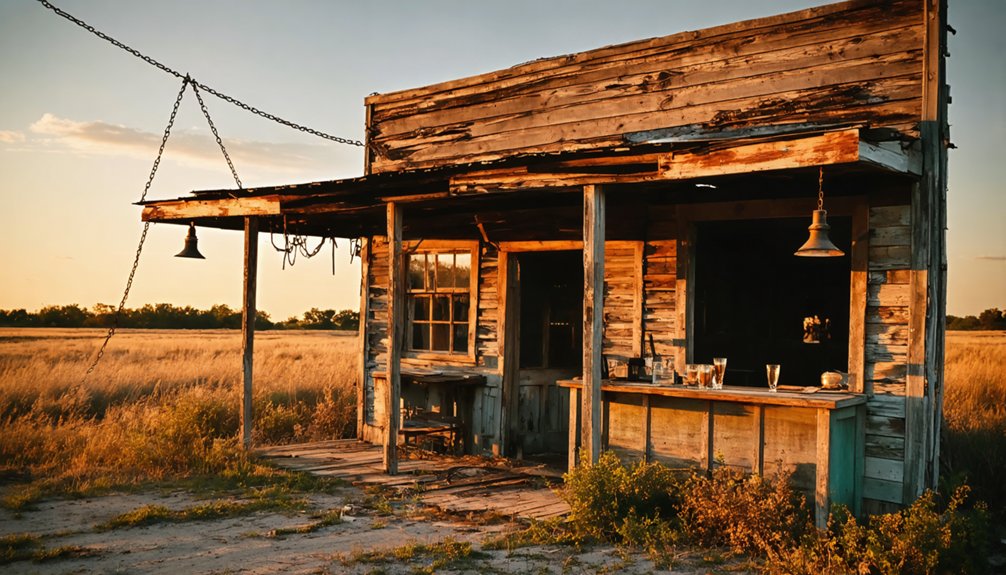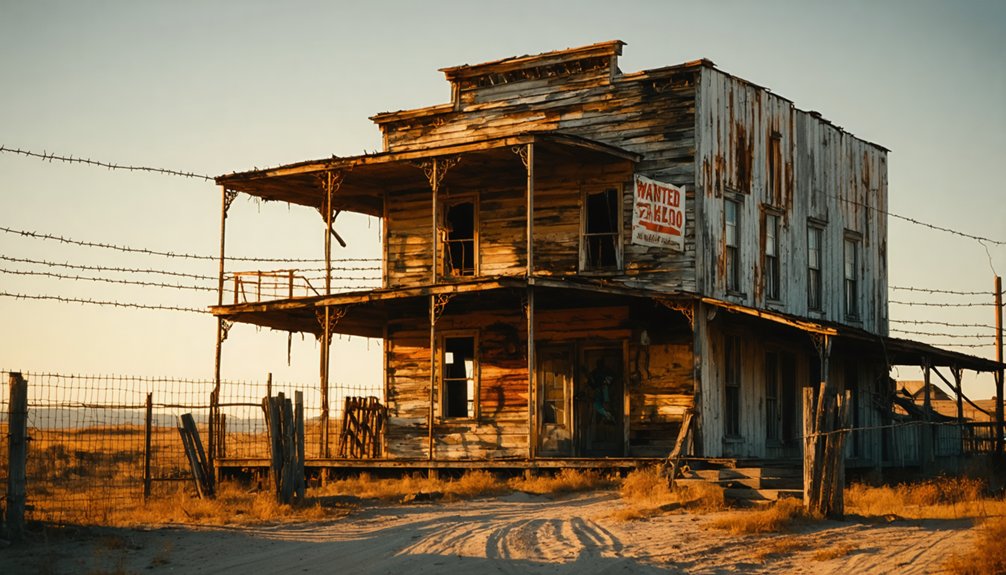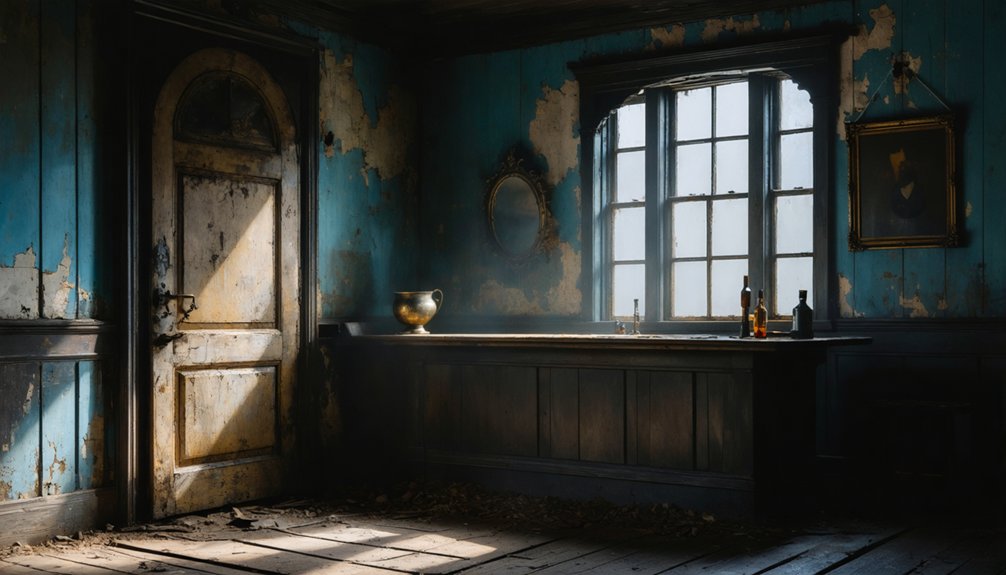You’ll discover fascinating ghost towns within day-trip distance of Phoenix, each telling a unique story of Arizona’s mining boom. Jerome’s mountainside copper heritage, Vulture City’s gold-laden past with its infamous Hanging Tree, and Goldfield’s family-friendly reconstructed western experience offer varied exploration opportunities. Wear sturdy boots and bring plenty of water when visiting these historic sites. The crumbling structures and abandoned mineshafts hold secrets waiting to be uncovered by curious travelers.
Key Takeaways
- Jerome features 88 miles of underground mine shafts and the famous Sliding Jail that shifted 200 feet downhill.
- Vulture City offers both guided and self-guided mine tours from October to May, showcasing original 1800s structures.
- Goldfield provides family-friendly activities including gunfight reenactments, gold panning, and narrow-gauge railroad rides.
- Visit between October and May for moderate temperatures, with winter offering clear skies for optimal ghost town photography.
- Wear sturdy boots, carry multiple light sources, and travel in groups when exploring abandoned structures for safety.
Jerome: Arizona’s Most Famous Mountainside Ghost Town

Perched dramatically on the steep slopes of Cleopatra Hill, Jerome stands as Arizona’s most renowned mountainside ghost town, boasting a tumultuous history deeply rooted in copper mining.
Once dubbed “the wickedest town in the West,” this settlement thrived with 15,000 residents representing over 30 nationalities during the early 1900s.
You’ll walk above an intricate labyrinth of 88 miles of mine shafts reaching 4,200 feet below ground—an underground network that yielded $800 million in copper before operations ceased in 1953.
The town’s ghost town legends live on through its Sliding Jail, which shifted 200 feet downhill due to geological instability. Today, visitors can explore Jerome’s haunted past through ghost tour experiences that include paranormal investigations with provided equipment.
Mining stories from Jerome’s colorful past—featuring bootlegging, gambling, and opium dens—are now preserved by the Historical Society formed by remaining residents who prevented the town’s complete demolition.
Artists and craftspeople revitalized this historic area in the 1960s and ’70s, transforming abandoned buildings into vibrant art galleries and studios.
The Gold Rush Legacy of Vulture City
When you visit Vulture City, you’ll encounter the dramatic rise and fall of Arizona’s most productive gold mine that generated $200 million in modern wealth before closing by executive order in 1942.
Today’s mine tours showcase historical structures including the infamous Hanging Tree, the schoolhouse, and blacksmith shop that once served a bustling population of 5,000 residents.
Beyond the visible remnants, Vulture City holds hidden treasures in its connections to notable figures like Horace Tabor and Jacob Waltz, alongside stories of gold robberies and lawlessness that characterized this quintessential Gold Rush settlement. The tragic 1923 Glory Hole Incident entombed seven miners beneath 100 feet of rock following a catastrophic ceiling collapse. Visitors can now experience this remarkable piece of Arizona history thanks to the preservation efforts that began in 2017 when Rod Prat and Robin Moriarty saved the site from demolition.
Rise and Fall
Deep within the sun-scorched deserts of Maricopa County, the story of Vulture City epitomizes the classic boom-and-bust cycle of Western mining towns. Following Wickenburg’s 1863 discovery, the site rapidly transformed from a barren outcropping to Arizona’s most productive gold mine, yielding 340,000 ounces of gold and 260,000 ounces of silver.
At its zenith, Vulture City supported nearly 5,000 residents with a fully functioning community infrastructure. The prosperity of the mine was instrumental in the founding of Wickenburg, providing an economic foundation for the area’s development. The mine changed hands multiple times, including ownership by Colorado silver magnate Horace Tabor in 1887.
Economic decline began gradually but accelerated dramatically with Roosevelt’s 1942 wartime executive order closing operations. Afterward, the once-thriving settlement slipped into abandonment, leaving behind a perfectly preserved ghost town.
It wasn’t until 2017 that restoration efforts began, now allowing you to experience this remarkable piece of Arizona’s gold rush legacy. Visitors can explore over 16 original buildings from the 1800s through self-guided tours of the site.
Mine Tour Experiences
Today, visitors to Vulture City can experience firsthand the gold rush legacy that defined Arizona’s territorial development. The site offers both guided and self-guided mine exploration options from October through May, with guided tours available on weekends that investigate the operational history and daily life of this once-thriving mining community.
The 12-acre historical preservation project showcases over a dozen original 1800s structures, including Henry Wickenburg’s cabin and the assay office. The mine, which produced over 340,000 ounces of gold during its operation, was instrumental in supporting Arizona’s economic growth.
You’ll have access to authentic hands-on experiences like gold panning and blacksmithing workshops. For those seeking deeper engagement, specialized evening tours explore the site’s reputed haunted history.
The 170-foot Nichols Raise mineshaft stands as a symbol of the engineering feats accomplished by early miners, illustrating the technological innovations that fueled Arizona’s economic development. The town was permanently abandoned after non-essential mines were ordered to close in 1942 by the War Production Board.
Vulture’s Hidden Treasures
The 1863 discovery of the Vulture Mine by prospector Henry Wickenburg fundamentally altered Arizona’s territorial development, establishing what would become the richest gold mine in state history.
You’re walking through a site that yielded an astounding 340,000 ounces of gold and 260,000 ounces of silver—worth approximately $200 million today.
Beyond these impressive figures lies a landscape rich with hidden artifacts and mining folklore. The “Hanging Tree” where 18 men met their fate for stealing gold stands as a grim reminder of frontier justice. At its peak in 1880, the population reached an impressive 5,000 frontier residents. When Jack Swilling reopened the irrigation canals in the Phoenix Valley, it transformed the region with agricultural development that initially supplied the mining community.
Vulture City’s ruins tell contradictory tales of immense wealth and ultimate abandonment. While thousands once sought fortune here, even Wickenburg himself died destitute after selling his stake.
The mine’s forced closure in 1942 preserved this time capsule of Western mining culture for your exploration.
Goldfield: Apache Trail’s Living Ghost Town Experience
At Goldfield Ghost Town, you’ll witness Arizona’s mining heritage through meticulously reconstructed buildings and authentic equipment collected from throughout the Southwest.
The family-friendly atmosphere offers immersive Wild West experiences including narrow-gauge railroad rides, gold panning activities, and historical gunfight reenactments performed by the Goldfield Gunfighters on Main Street.
Extensive guided tours take you through the underground mining tunnels where experienced guides explain historical mining procedures while paranormal enthusiasts can opt for specialized “Fear Frontier” tours highlighting the town’s reported ghostly encounters.
Mining Heritage On Display
Five distinct mining heritage attractions await visitors at Goldfield Ghost Town, offering immersive experiences that showcase the area’s rich gold mining past.
When you explore the historic Mammoth Gold Mine on a guided tour, you’ll gain insights into mining techniques used during the 1890s gold rush. The Goldfield Museum houses an impressive collection of historical artifacts and equipment that tells the story of the town’s boom-and-bust cycle.
- Hands-on gold panning activities let you try your luck at discovering gold flakes
- Reconstructed mining tunnel and stope provide authentic underground exploration
- Vintage mining machinery collected from throughout the Southwest region
- Detailed exhibits explaining ore extraction and processing methods
- Educational displays showing the economic impact of mining on territorial Arizona
Family-Friendly Wild West
Goldfield Ghost Town provides families with an exceptional Wild West experience that balances historical authenticity with engaging entertainment options suitable for visitors of all ages.
You’ll witness thrilling gunfights performed by the famous Goldfield Gunfighters on Main Street while period characters roam the grounds, creating immersive historical education opportunities.
Children particularly enjoy panning for gold and riding Arizona’s only operational narrow-gauge railroad, connecting them directly with the town’s 1893 mining heritage.
The reconstructed buildings—including the general store, blacksmith shop, and saloons—transport you to the days when prospectors like Hakes and Morse first discovered gold in the Superstition Mountains.
The Mammoth Gold Mine tour and Goldfield Museum offer deeper insights into mining practices while maintaining family fun as the primary focus throughout this meticulously preserved slice of Arizona’s territorial past.
Guided Tours Available
When you visit Goldfield Ghost Town along the historic Apache Trail, you’ll discover a wealth of expertly guided tours that bring Arizona’s mining heritage to life.
The Mammoth Gold Mine tour offers an authentic 25-minute underground experience recreating mining conditions from a century ago, with departures every 10 minutes for efficient access to historical reenactments.
- Mammoth Gold Mine tours ($12/adults, $10/seniors, $8/children 5-12) operate daily
- Spirits of the Bordello tour provides immersive “haunt and hunt” experiences in authentic settings
- Fear Frontier paranormal investigations access restricted areas beneath the town
- Superstition Narrow Gauge Railroad offers Arizona’s only 3-foot gauge rail experience
- Specialized ghost town experiences include both daytime and nighttime paranormal tours
These historically accurate guided experiences, developed since Robert Schoose’s 1966 discovery, transform what was once an abandoned settlement into an educational window to Arizona’s golden past.
Tip Top: Off-Road Adventures in the Bradshaw Mountains
Nestled in the southern foothills of the Bradshaw Mountains lies Tip Top, one of Arizona’s most intriguing ghost towns with a rich silver mining history dating back to 1875. Founded by Jack Moore and Bill Corning, this once-thriving community produced over $4 million in silver before operations ceased in 1884.
You’ll need to access the site via the Tip Top Mine Trail west of Black Canyon City. At its peak, this mining settlement housed 1,200 residents, featuring six saloons, three stores, and even Arizona’s first brewery.
The mine shafts reached impressive depths of 830 feet, with high-grade ore found primarily in the upper 500 feet.
While historical structures remain, note that Tip Top is currently on private property and closed to the public. Respect posted signs and gates during your off-road expedition.
Courtland’s Forgotten Copper Boom
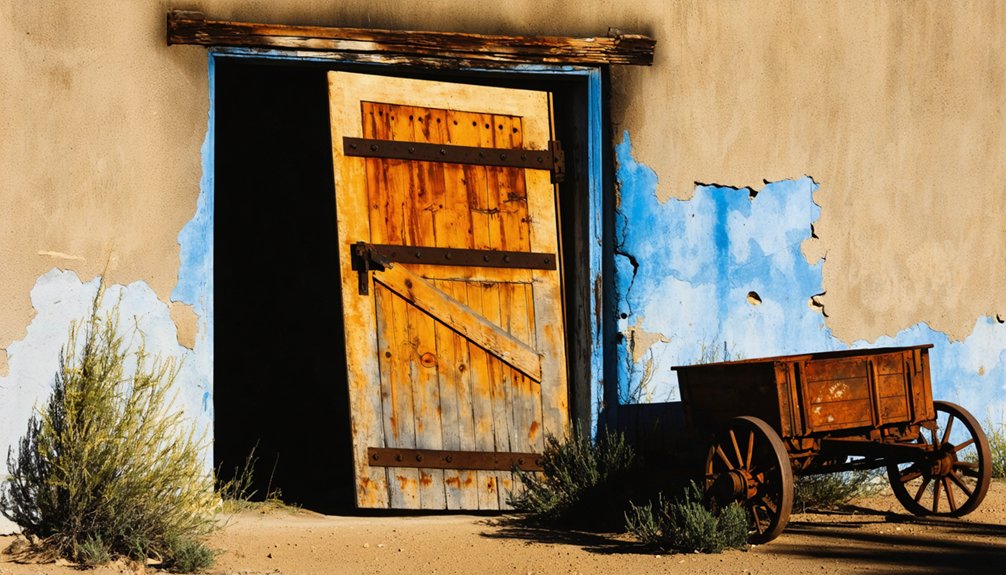
While Tip Top’s silver rush shaped central Arizona’s mining history, Courtland presents a different chapter in the state’s mineral exploitation saga, focused on copper rather than precious metals. Founded in 1909 and named after Courtland Young, this settlement rapidly transformed from a tent city into a thriving community of 2,000 residents.
Unlike typical company towns, Courtland’s businesses remained independently owned, contributing to its unique mining legacy.
- Originally known as Leadville before the Young brothers purchased claims in 1899
- Connected by two railroads that facilitated the transport of 1.75 million tons of copper ore
- Experienced a relatively short boom period (1909-1920) before shallow copper deposits were exhausted
- Features a reinforced concrete jail as the only intact remaining structure
- Officially became a ghost town by 1942 when the post office closed
Safety Tips for Ghost Town Explorers
Exploring the haunting remains of Arizona’s ghost towns requires thorough preparation and awareness of potential dangers that lurk in these deteriorating historical sites.
Essential ghost town safety practices include traveling in groups of at least three people, informing someone of your plans, and maintaining group cohesion throughout your expedition.
Never explore alone – bring companions, share your itinerary, and stay together when investigating these fragile historical remnants.
Your exploration gear should include sturdy boots with ankle support, protective gloves, multiple light sources, and respirators to prevent inhaling hazardous particles.
Always hug walls when maneuvering through structures, as they provide better structural support. Look upward before entering rooms to assess collapse risks. Carry identification, a first-aid kit, and sufficient water.
Respect both legal and ethical boundaries—obtain permission before entering private property, take only photographs, and leave these historical treasures undisturbed for future adventurers.
Best Times to Visit Desert Ghost Towns
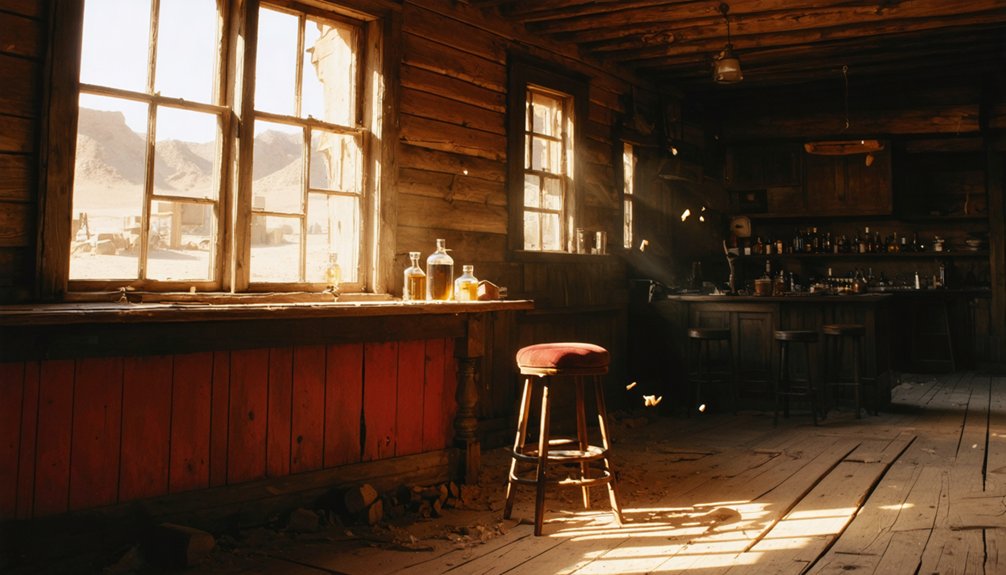
The ideal timing for desert ghost town visits near Phoenix follows a predictable seasonal pattern dictated by the region’s harsh climate conditions. For the best visiting times, plan your exploration between October and May when temperatures remain moderate and outdoor activities become genuinely enjoyable rather than exercises in endurance.
During summer months (June-September), temperatures regularly exceed 100°F, making exploration potentially dangerous.
- Weekday mornings offer the lightest crowds and most comfortable temperatures.
- Winter provides clear skies and optimal photography conditions, though layers are recommended for cool mornings.
- Avoid monsoon season (July-September) when flash floods and dust storms present real hazards.
- Consider timing visits around Old West-themed events for enhanced historical experiences.
- Spring and fall shoulder seasons balance comfortable weather with fewer tourists than peak winter months.
Photography Guide: Capturing Historic Ruins
Historic ruins of abandoned settlements demand specialized photographic approaches to authentically capture their haunting essence and architectural legacy.
When documenting abandoned architecture, prioritize wide-angle lenses for establishing shots that contextualize entire town layouts, while prime lenses reveal intimate details of forgotten artifacts.
During golden hour, natural shaft lighting dramatically illuminates structural elements, creating depth through foreground, middle ground, and background composition.
That magical moment when angled light transforms forgotten hallways into sacred passages between past and present
Employ tripods for low-light exploration, especially when creating long exposures of star trails above silent towns.
Your photographic storytelling should focus on key buildings—jails, saloons, churches—while including architectural details like rusting door handles and weathered window frames.
Consider post-processing in black and white or sepia to enhance contrast between deteriorated structures and their surroundings, crafting visual narratives that pose questions rather than merely documenting decay.
Frequently Asked Questions
Can Children Safely Visit These Ghost Towns?
Yes, children can safely visit with proper supervision. Well-established ghost towns offer child safety measures and family-friendly ghost town activities, but you’ll need to remain vigilant about hazards and amenities.
Are Pets Allowed at the Ghost Town Sites?
Like faithful sidekicks in a frontier tale, your pets are welcome at Goldfield Ghost Town. Pet regulations vary across ghost town policies, so confirm before visiting others—leashed dogs enjoy most outdoor attractions.
Do Any Ghost Towns Offer Overnight Accommodations?
Yes, you can stay at the Kentucky Camp cabin, Jerome Grand Hotel, or Tombstone Monument Ranch. Ghost town hotels offer authentic experiences while overnight camping isn’t typically permitted at these historic sites.
What Paranormal Activity Has Been Reported in These Towns?
You’ll encounter ghost sightings throughout these towns, including apparitions in Jerome’s Grand Hotel and dancing specters in Flagstaff. Eerie sounds like miners’ footsteps and mysterious whispers permeate these historically charged locations.
Are Metal Detectors Permitted at Any of These Locations?
You’d think freedom means waving your metal detector wherever you please, but alas—regulations strictly limit metal detecting at ghost towns due to their historical significance. You’ll need specific permits or landowner permission.
References
- https://en.wikipedia.org/wiki/List_of_ghost_towns_in_Arizona
- https://www.elitevrs.com/blog/discover-these-top-10-ghost-towns-arizona
- https://www.arizonahighways.com/article/arizona-ghost-towns
- https://www.visitarizona.com/like-a-local/4-arizona-ghost-towns-you-may-have-never-heard-of
- https://www.youtube.com/watch?v=Q18D1sHH2Cc
- https://goldfieldghosttown.com
- https://www.tripadvisor.com/Attractions-g28924-Activities-c47-t14-Arizona.html
- https://www.travelbackland.com/post/jerome-arizona-spend-a-day-in-america-s-largest-ghost-town
- https://jerome.az.gov/jerome-then-and-now
- https://www.sedona.net/jerome

